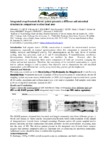Please use this identifier to cite or link to this item:
http://www.alice.cnptia.embrapa.br/alice/handle/doc/1022253| Title: | Integrated crop-livestock-forest system presents a different soil microbial structure in comparison to other land uses. |
| Authors: | LEITE, D. C. A.  BALIEIRO, F. de C.   LEITE, L. F. C.   MADARI, B. E.   RIBEIRO, A. de F.   PEIXOTO, R. S.   ROSADO, A. S.   |
| Affiliation: | DEBORAH C. A. LEITE, UFRJ; FABIANO DE CARVALHO BALIEIRO, CNPS; LUIZ FERNANDO CARVALHO LEITE, CPAMN; BEATA EMOKE MADARI, CNPAF; ALCIONE DE FRANÇA RIBEIRO, UFPI; RAQUEL S. PEIXOTO, UFRJ; ALEXANDRE S. ROSADO, UFRJ. |
| Date Issued: | 2015 |
| Citation: | In: WORLD CONGRESS ON INTEGRATED CROP-LIVESTOCK-FOREST SYSTEMS; INTERNATIONAL SYMPOSIUM ON INTEGRATED CROP-LIVESTOCK SYSTEMS, 3., 2015, Brasília, DF. Towards sustainable intensification: proceedings. Brasília, DF: Embrapa, 2015. |
| Description: | Soil organic matter (SOM) conservation is essential for environmental services maintenance, especially in tropical agroecosytems where this component is essential for soil fertility, structure and biological activity. Soil microorganisms are the main driver of nutrient cycling, since key processes, such as C and N mineralization, N immobilization, xenobiotics decomposition, denitrification and others are mediated by them. However when the agroecosystems are manipulated, these active components of soils are impacted, changing the carbon and nutrient dynamics. Therefore, the monitoring of the microbial communities is a good tool to indicate changes in soil dynamics. Our objective was to characterize the soil microbial communities under different land uses by using denaturing gradient gel electrophoresis. |
| Thesagro: | Uso da terra Microbiologia do solo |
| Type of Material: | Resumo em anais e proceedings |
| Access: | openAccess |
| Appears in Collections: | Resumo em anais de congresso (CNPS)  |
Files in This Item:
| File | Description | Size | Format | |
|---|---|---|---|---|
| 2015034.pdf | 80,86 kB | Adobe PDF |  View/Open |









